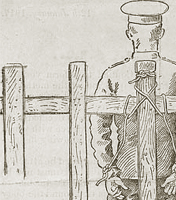
Field Punishment No. 1 (detail)
Library and Archives Canada
RG9 III-C-3, vol. 4121, folder 2, file 6 |
Like their civil counterparts, courts martial were legal bodies that are convened to determine the guilt or innocence of accused men and women. A panel of officers sat in judgement at a court martial, while the accused was represented by an officer who may have been a military lawyer. Courts martial had the authority to try a wide range of military offences, many of which closely resembled civilian crimes like fraud, theft or perjury. Others, like desertion and cowardice were purely military crimes. Punishments for military offences ranged from fines and imprisonment to execution. Military offenses were defined in the British Army Act. These offences, their corresponding punishments and instructions on how to run a court martial, were explained in detail in the Manual of Military Law, which was distributed to Canadian Expeditionary Force units. |